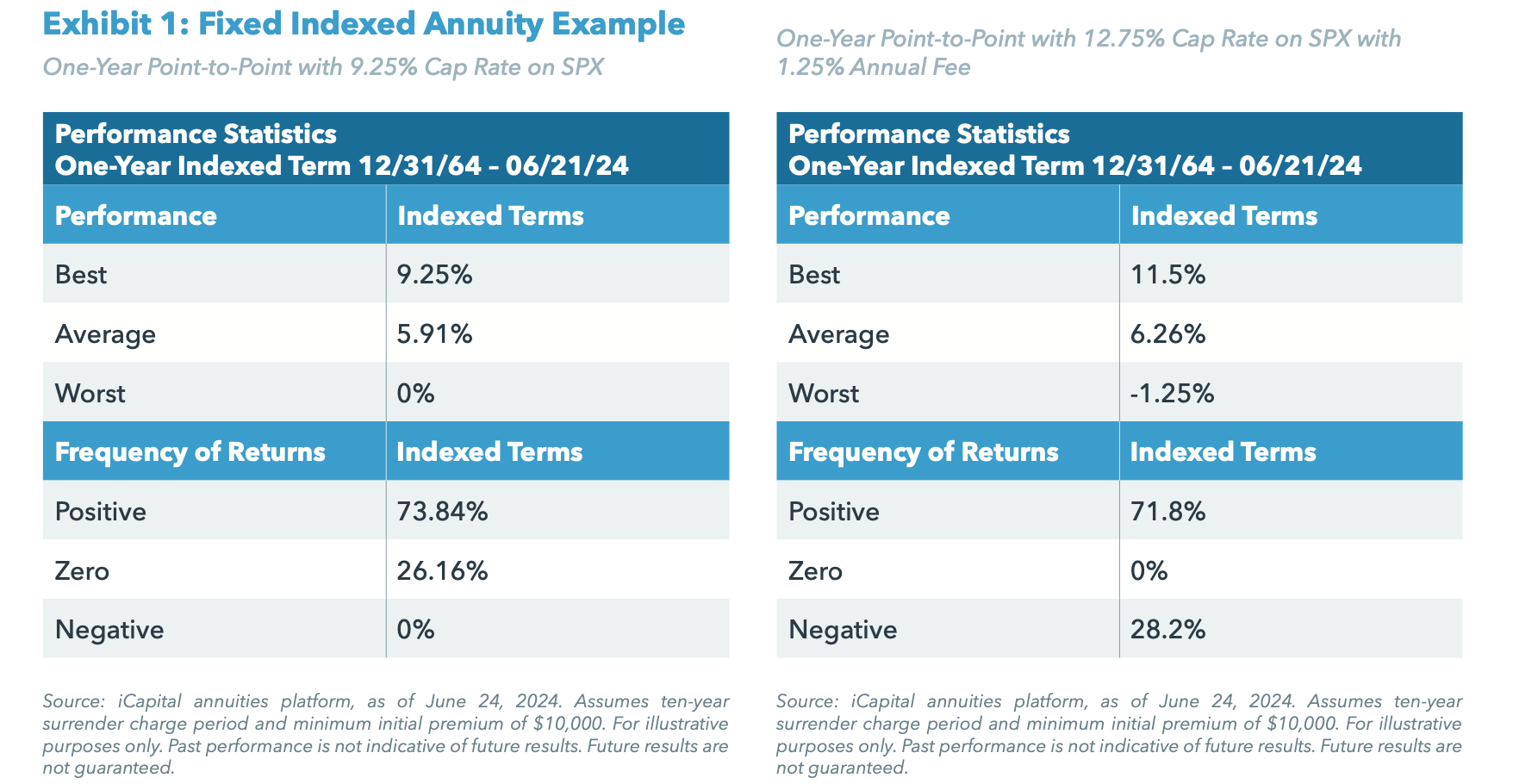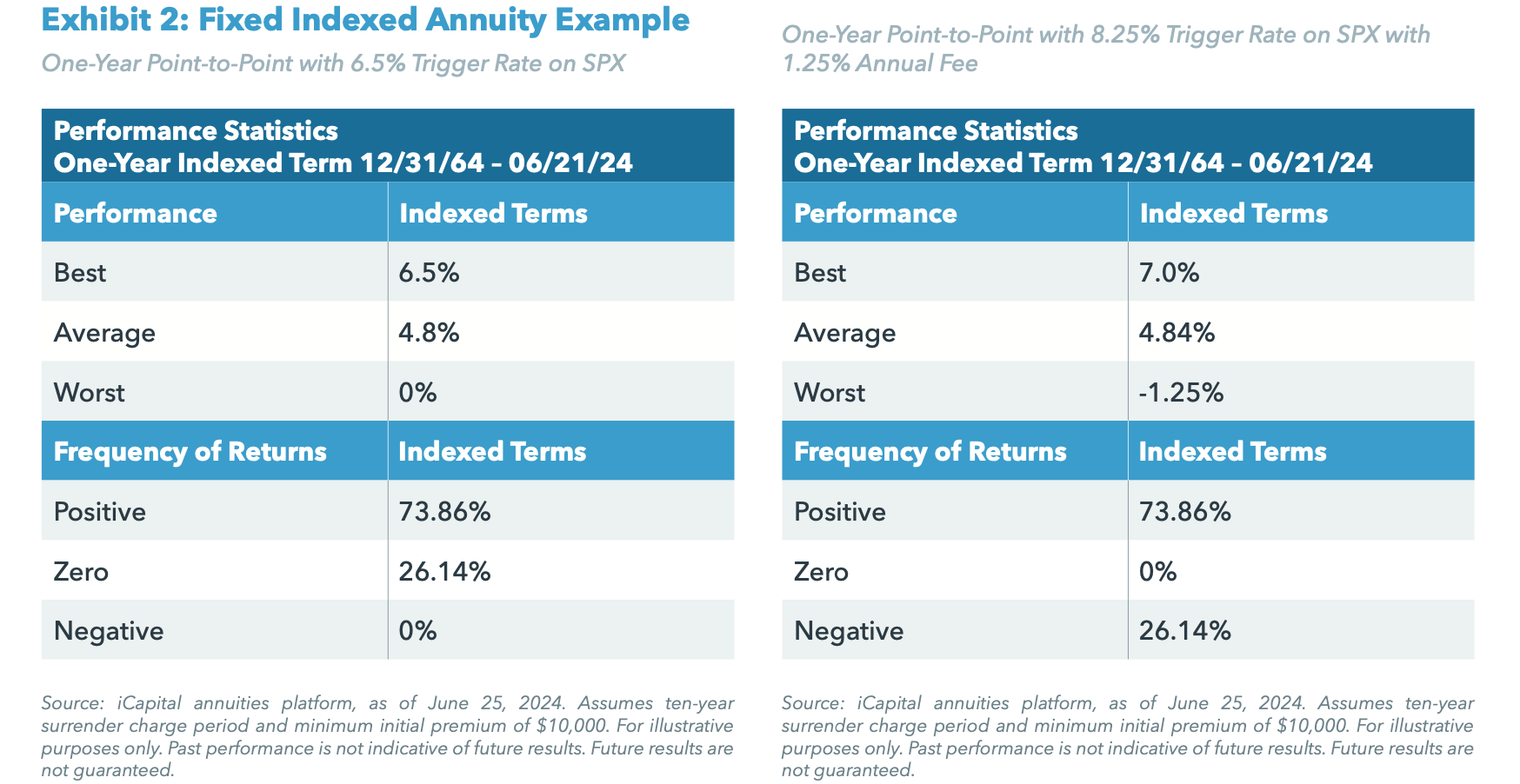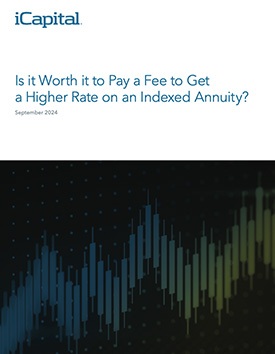You have to choose between several indexes and crediting terms lengths, and from an increasing number of products that offer the option of paying a fee for a higher participation cap or trigger rate. This option is found most often on a crediting strategy with a volatility-controlled index, but can also be on more common indexes such as the S&P 500. For example, as of June 24, 2024, one FIA offers a one-year point-to-point strategy on the S&P 500 with a 9.25% cap rate with no fee vs. 12.75% cap rate with a 1.25% fee.
To quantify whether it’s worth paying 1.25% per year for potentially 2.25% more return (3.5% cap rate difference minus the 1.25% fee), you need to know both how often the price of the S&P 500 index will increase by more than 9.25%, and by how much, because you only get the full 2.25% differential if the index price increases by 12.75% or more. If it’s up just 10%, then the contract will credit only 8.75% net of the fee.
Let’s look at how a one-year point-to-point strategy on the S&P 500 with a 9.25% cap rate with no fee vs. 12.75% cap rate with a 1.25% fee would have compared historically.
The below tables (Exhibit 1) show two cap rates on the S&P 500 for every one-year period ended since December 1964. Since the first strategy can’t yield a return of more than the 9.25% cap in any given year, the average annualized return would have been 5.91% with 100% protection against any negative annual return. More important, historically, the strategy would have had a positive return in almost 3 out of every 4 one-year periods.
The best possible return on the fee option is 11.5% (the 12.75% cap less the 1.25% fee). The average annualized return would have been 6.26%, or 0.35% more per year than the strategy without the fee. But because the fee is still deducted anytime the price of the index falls, all of the annual results that would have created a 0% return for the year now create a loss anytime the price does not increase by at least 1.25%. That 1.25% hurdle also shows a slight drop in the percentage of times the strategy creates a positive return.
Is the possible additional 0.35% return per year worth the chance that the client could incur a slight loss about one in every four-year annual period? That depends upon the risk profile of your client and your willingness to back off of recommending a strategy with 100% downside protection.
Now let’s look at a trigger rate example (Exhibit 2). This same product also offered a 6.5% trigger rate with no fee vs. 8.25% trigger rate with a 1.25% fee.
Since this strategy pays a specific return as long as the index price does not fall, we see the non-fee version always pays 6.5% if interest is credited, while the fee version always pays 7.0% (8.25% less the 1.25% fee). Given these rates, the most benefit in any one year is 0.5%. In addition, since the 7.0% net of the fee is credited anytime the index is higher, unlike our previous example, this strategy will not generate a negative return when the index is up between 0.0% and 1.25%. The trigger rate version will only generate a negative return if the index goes down in price. Just how much extra return would your client get on average by paying a fee to get a 7.0% trigger rate net of that fee? In the example below, as of June 25, 2024, an FIA offers a one-year point-to-point strategy on the S&P 500 with a 6.5% trigger rate with no fee vs. 8.25% trigger rate with a 1.25% fee.
It’s unlikely that an advisor armed with the above information would recommend the higher trigger rate with the fee, given the limited additional return net of 1.25%. They would not likely choose to turn the 26.14% of the 0% occurrences to slightly negative return occurrences. However, the advisor might reconsider if the gap between the trigger rate with the fee and the trigger rate without the fee widens. These variables make it vital to check historical data to weigh the trade-offs anytime the insurance company changes its rates.
OTHER CONSIDERATIONS
While the data that technology can deliver is a powerful tool for making better recommendations, advisors should also factor in:
1. The data is based on historical average returns. While this context can help inform your decisions, the actual future returns will most likely differ.
2. The initial cap and trigger rates are not guaranteed in subsequent years. A change in differential between the cap or trigger rates without the fee vs. the rates with the fees will alter the actual results. A widening of the rate differential will help the rate with the fee, while the opposite will occur if the rate differential is reduced.
3. Most FIAs have a surrender charge period of seven years or longer and are typically suitable only if the client has an expected holding period of at least the length of the surrender charge period.
CONCLUSIONS
Much of the appeal of FIAs comes from the comfort clients find in 100% downside protection. Anytime an advisor chooses to recommend a strategy with a fee, the client discussion must change from “you can’t lose” during any strategy period, to “you can only lose (the size of the fee).” Some clients will accept that trade-off if the expected return is sufficiently greater. For those that are willing to occasionally incur a minor loss, the decision becomes about how much additional return they expect to get in return for this trade-off. The good news is that the data exists to measure this trade-off. But remember, your conclusions can change every time rates change. Sometimes paying the fee will make sense. And other times it will not.
IMPORTANT INFORMATION
The material herein has been provided to you for informational purposes only by Institutional Capital Network, Inc. (“iCapital Network”) or one of its affiliates (iCapital Network together with its affiliates, “iCapital”). This material is the property of iCapital and may not be shared without the written permission of iCapital. No part of this material may be reproduced in any form, or referred to in any other publication, without express written permission of iCapital.
This material is provided for informational purposes only and is not intended as, and may not be relied on in any manner as, legal, tax or investment advice, a recommendation, or as an offer or solicitation to buy or sell any security, financial product or instrument, or otherwise to participate in any particular trading strategy. This material does not intend to address the financial objectives, situation, or specific needs of any individual investor. You should consult your personal accounting, tax and legal advisors to understand the implications of any investment specific to your personal financial situation.
ANNUITIES ARE CONSIDERED COMPLEX PRODUCTS AND MAY NOT BE SUITABLE FOR ALL INVESTORS. The information is not intended as investment advice and is not a recommendation about managing or investing retirement savings. Actual annuity contracts may differ materially from the general overview provided. Prior to making any decision with respect to an annuity contract, purchasers must review, as applicable, the offering document, the disclosure document, and the buyer’s guide which contain detailed and additional information about the annuity. Any annuity contract is subject in its entirety is to the terms and conditions imposed by the carrier under the contract. Withdrawals or surrenders may be subject to surrender charges, and/or market value adjustments, which can reduce the owner’s contract value or the actual withdrawal amount received. Withdrawals and distributions of taxable amounts are subject to ordinary income tax and, if made prior to age 591⁄2, may be subject to an additional 10% federal income tax penalty. Annuities are not FDIC-insured. All references to guarantees arising under an annuity contract are subject to the financial strength and claims-paying ability of the carrier.
iCapital Markets LLC operates a platform that makes available financial products to financial professionals. In operating this platform, iCapital Markets LLC generally earns revenue based on the volume of transactions that take place in these products and would benefit by an increase in sales for these products.
The information contained herein is an opinion only, as of the date indicated, and should not be relied upon as the only important information available. Any prediction, projection or forecast on the economy, stock market, bond market or the economic trends of the markets is not necessarily indicative of the future or likely performance. The information contained herein is subject to change, incomplete, and may include information and/or data obtained from third party sources that iCapital believes, but does not guarantee, to be accurate. iCapital considers this third-party data reliable, but does not represent that it is accurate, complete and/or up to date, and it should not be relied on as such. iCapital makes no representation as to the accuracy or completeness of this material and accepts no liability for losses arising from the use of the material presented. No representation or warranty is made by iCapital as to the reasonableness or completeness of such forward-looking statements or to any other financial information contained herein.
Securities products and services are offered by iCapital Markets, an SEC-registered broker-dealer, member FINRA and SIPC, and an affiliate of iCapital, Inc. and Institutional Capital Network, Inc. These registrations and memberships in no way imply that the SEC, FINRA, or SIPC have endorsed any of the entities, products, or services discussed herein. Annuities and insurance services are provided by iCapital Annuities and Insurance Services LLC, an affiliate of iCapital, Inc. “iCapital” and “iCapital Network” are registered trademarks of Institutional Capital Network, Inc. Additional information is available upon request.
© 2024 Institutional Capital Network, Inc. All Rights Reserved. | 2024.06




















